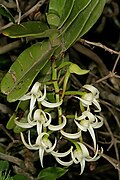
Angraecopsis is a genus of plants in the family Orchidaceae. It was first described by Fritz Kraenzlin in 1900 and given its name on account with the genus' similarity to Angraecum species. Angraecopsis are native to Africa, Madagascar, Réunion, Mauritius and the Comoros. The growth habit is rather small and the leaves emerge from a woody stem.
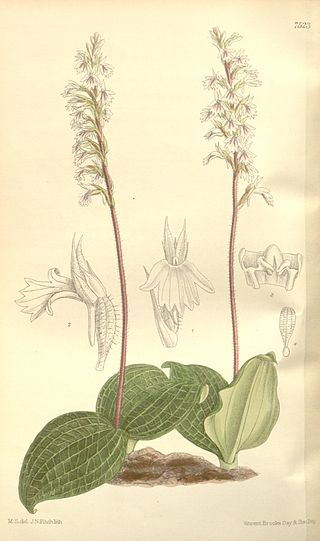
Holothrix is a genus of plants in family Orchidaceae. It contains the following species :
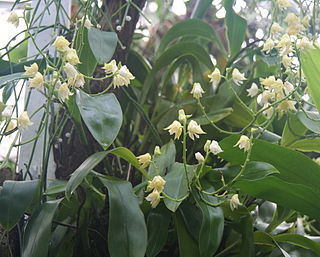
Polystachya, abbreviated Pol in horticultural trade, and commonly known as yellowspike orchid, is a flowering plant genus in the orchid family (Orchidaceae). This rather distinctive genus was described by William Jackson Hooker in 1824 and is the type genus of the subtribe Polystachyinae. It contains about 100 species widespread across many of the tropical areas of the world.

Jumellea is an orchid genus with 55 species native to Madagascar, the Comoros, the Mascarenes, and eastern Africa. In horticulture, it is often abbreviated Jum.
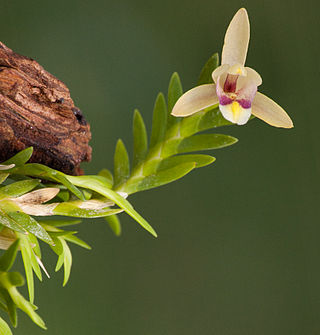
The Vandeae is a large monophyletic tribe within the family of orchids.
Bulbophyllum mediocre is a species of orchid in the genus Bulbophyllum.

Hippotion is a genus of sphinx moths. The genus was erected by Jacob Hübner in 1819.

Ancistrorhynchus is a genus of flowering plants from the orchid family Orchidaceae. It contains 16 species native to tropical Africa.

Bolusiella is a genus of flowering plants from the orchid family, Orchidaceae. It consists of 4 currently recognized species that are endemic to sub-Saharan Africa and the Comoro Islands.

Brachycorythis is a genus of flowering plants from the orchid family, Orchidaceae. It contains approximately 40-50 species native mostly to Africa and Madagascar but also some from South and East Asia.
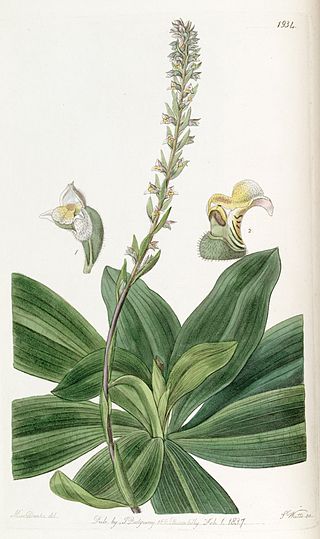
Brachystele is a genus of flowering plants from the orchid family, Orchidaceae. It consists of 20 species native primarily to South America but with a few species in Mexico, Central America, and Trinidad & Tobago.
- Brachystele arechavaletae(Kraenzl.) Schltr.
- Brachystele bicrinitaSzlach.
- Brachystele bracteosa(Lindl.) Schltr.
- Brachystele burkartiiM.N.Correa
- Brachystele camporum(Lindl.) Schltr.
- Brachystele chlorops(Rchb.f.) Schltr.
- Brachystele cyclochila(Kraenzl.) Schltr.
- Brachystele delicatula(Kraenzl.) Schltr.
- Brachystele dilatata(Lindl.) Schltr.
- Brachystele guayanensis(Lindl.) Schltr.
- Brachystele luzmarianaSzlach. & R.González
- Brachystele maasiiSzlach.
- Brachystele oxyanthosSzlach
- Brachystele pappulosaSzlach
- Brachystele scabrilinguaSzlach
- Brachystele subfiliformis(Cogn.) Schltr
- Brachystele tamayoanaSzlach.
- Brachystele unilateralis(Poir.) Schltr
- Brachystele waldemariiSzlach.
- Brachystele widgrenii(Rchb.f.) Schltr.

Calyptrochilum is a genus of flowering plants from the orchid family Orchidaceae native to tropical Africa, with one species extending into Brazil.

Diaphananthe is a genus of flowering plants from the orchid family, Orchidaceae. As currently conceived, it contains 33 accepted species, all endemic to sub-Saharan Africa.

Eurystyles is a genus of flowering plants from the orchid family, Orchidaceae. It contains over 20 known species native to South America, Central America, the West Indies and Chiapas.
- Eurystyles actinosophila(Barb.Rodr.) Schltr.
- Eurystyles alticolaDod
- Eurystyles ananassocomus(Rchb.f.) Schltr.
- Eurystyles borealisA.H.Heller
- Eurystyles christensoniiD.E.Benn.
- Eurystyles cogniauxii(Kraenzl.) Schltr.
- Eurystyles cornu-bovisSzlach.
- Eurystyles cotyledonWawra
- Eurystyles cristata(Schltr.) Schltr.
- Eurystyles crocodilusSzlach.
- Eurystyles domingensisDod
- Eurystyles gardneri(Lindl.) Garay
- Eurystyles guentheriana(Kraenzl.) Garay
- Eurystyles hoehneiSzlach.
- Eurystyles lobataChiron & V.P.Castro
- Eurystyles lorenzii(Cogn.) Schltr.
- Eurystyles luisortizii
- Eurystyles ochyrana(Szlach., Mytnik & Rutk.) F.Barros & L.R.S.Guim.
- Eurystyles rutkowskianaSzlach.
- Eurystyles splendissimaSzlach.
- Eurystyles standleyiAmes
Tridactyle is a genus of flowering plants from the orchid family, Orchidaceae. It has about 60-70 known species, all native to sub-Saharan Africa.

Psilochilus is a genus of flowering plants from the orchid family, Orchidaceae. It is native to South America, Central America, Mexico and the West Indies.
- Psilochilus carinatusGaray - Colombia
- Psilochilus dusenianusKraenzl. ex Garay & Dunst. - Venezuela, Brazil
- Psilochilus macrophyllus(Lindl.) Ames - widespread from central Mexico and the West indies south to Peru
- Psilochilus maderoi(Schltr.) Schltr. - Colombia
- Psilochilus modestusBarb.Rodr. - Venezuela, Brazil
- Psilochilus mollisGaray - Ecuador
- Psilochilus physurifolius(Rchb.f.) Løjtnant - Venezuela, Guyana
- Psilochilus vallecaucanusKolan. & Szlach. - Colombia

Solenangis is a genus of flowering plants from the orchid family, Orchidaceae. It is native to sub-Saharan Africa.

Rhipidoglossum is a genus of flowering plants from the orchid family, Orchidaceae. It contains about 20-30 species, all from sub-Saharan Africa.




